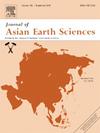Petrogenesis of Early Cretaceous volcanic rocks in the Tuoyun Basin, western Central Asian Orogenic Belt: Implications for crust–mantle interaction
IF 2.7
3区 地球科学
Q2 GEOSCIENCES, MULTIDISCIPLINARY
引用次数: 0
Abstract
The petrogenesis of continental intraplate basalts has been widely debated, primarily due to the uncertainties surrounding their thermal state and the role of recycled materials. Herein, we focus on the Early Cretaceous basalts from the Tuoyun Meso-Cenozoic volcanic basin, located in the western Central Asian Orogenic Belt. The samples are porphyritic, with phenocrysts predominantly composed of olivine, clinopyroxene, and plagioclase. Primitive mantle-normalized incompatible trace element patterns and chondrite-normalized rare earth element patterns show a strong ocean island basalt affinity. The Zn/Fe, Mn/Zn, and Fe/Mn ratios in olivine suggest a mixed source of peridotite and pyroxenite. This is further supported by trends in the whole-rock CaO–MgO compositions, FeO/MnO ratios (42.1–106.5), and FCKANTMS values (0.52–0.82). Additionally, the basalts exhibit significantly lighter Mg and heavier Zn isotopic compositions compared to the normal mantle, suggesting the involvement of recycled sedimentary carbonates. However, the olivine SIMS in situ oxygen isotopes show reveal that the Early Cretaceous basalts in the Tuoyun Basin have normal mantle oxygen isotope compositions, with δ18OV-SMOW values ranging from 5.12 ‰ to 5.76 ‰. Moreover, the absence of typical carbonate signatures, such as negative anomalies in Zr, Hf, and Ti in the trace elemental spider diagram, indicates that carbonates did not participate in the partial melting of the mantle source. The decoupling of O and Mg–Zn isotopic signatures suggests that recycled carbonates may have decomposed during subduction. Overall, this study implies that the formation of intraplate basalts may be significantly influenced by recycled oceanic crust derived from ancient subducted slabs.
中亚西部造山带沱云盆地早白垩世火山岩成因及其壳幔相互作用意义
大陆板内玄武岩的岩石成因一直存在广泛的争论,主要是由于围绕其热状态和回收材料作用的不确定性。本文以中亚造山带西部沱云中新生代火山盆地的早白垩世玄武岩为研究对象。样品呈斑状,斑晶主要由橄榄石、斜辉石和斜长石组成。原始地幔归一化不相容微量元素模式和球粒陨石归一化稀土元素模式显示出较强的洋岛玄武岩亲和性。橄榄石的Zn/Fe、Mn/Zn和Fe/Mn比值表明橄榄岩和辉石岩的混合来源。整个岩石的CaO-MgO组成、FeO/MnO比值(42.1 ~ 106.5)和FCKANTMS值(0.52 ~ 0.82)的变化趋势进一步支持了这一观点。此外,与正常地幔相比,玄武岩表现出较轻的Mg和较重的Zn同位素组成,表明其参与了再循环沉积碳酸盐岩。而橄榄石SIMS原位氧同位素显示,沱云盆地早白垩世玄武岩具有正常的地幔氧同位素组成,δ18OV-SMOW值在5.12‰~ 5.76‰之间。此外,微量元素蜘蛛图中没有典型的碳酸盐特征,如Zr、Hf和Ti的负异常,表明碳酸盐没有参与地幔源的部分熔融。O和Mg-Zn同位素特征的解耦表明,再循环碳酸盐岩可能在俯冲过程中发生了分解。综上所述,本研究表明,板内玄武岩的形成可能受到源自古俯冲板块的再循环洋壳的显著影响。
本文章由计算机程序翻译,如有差异,请以英文原文为准。
求助全文
约1分钟内获得全文
求助全文
来源期刊

Journal of Asian Earth Sciences
地学-地球科学综合
CiteScore
5.90
自引率
10.00%
发文量
324
审稿时长
71 days
期刊介绍:
Journal of Asian Earth Sciences has an open access mirror journal Journal of Asian Earth Sciences: X, sharing the same aims and scope, editorial team, submission system and rigorous peer review.
The Journal of Asian Earth Sciences is an international interdisciplinary journal devoted to all aspects of research related to the solid Earth Sciences of Asia. The Journal publishes high quality, peer-reviewed scientific papers on the regional geology, tectonics, geochemistry and geophysics of Asia. It will be devoted primarily to research papers but short communications relating to new developments of broad interest, reviews and book reviews will also be included. Papers must have international appeal and should present work of more than local significance.
The scope includes deep processes of the Asian continent and its adjacent oceans; seismology and earthquakes; orogeny, magmatism, metamorphism and volcanism; growth, deformation and destruction of the Asian crust; crust-mantle interaction; evolution of life (early life, biostratigraphy, biogeography and mass-extinction); fluids, fluxes and reservoirs of mineral and energy resources; surface processes (weathering, erosion, transport and deposition of sediments) and resulting geomorphology; and the response of the Earth to global climate change as viewed within the Asian continent and surrounding oceans.
 求助内容:
求助内容: 应助结果提醒方式:
应助结果提醒方式:


